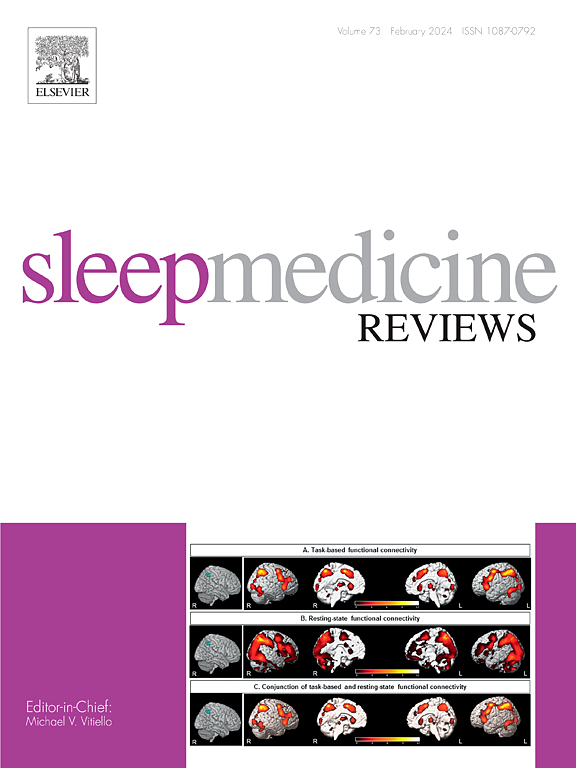探讨阻塞性睡眠呼吸暂停和不宁腿综合征共病(Co-ROSA):一项系统综述。
IF 9.7
1区 医学
Q1 CLINICAL NEUROLOGY
引用次数: 0
摘要
目的:系统评估RLS和OSA合并症患者的患病率、临床概况和治疗结果,并评估OSA治疗对RLS症状的影响。方法:我们对截至2025年8月在MedLine、PubMed和EMBASE中检索的观察性研究进行了系统回顾。该审查遵循PRISMA的指导方针,并在PROSPERO进行了登记。纳入标准是报告患有RLS和OSA合并症的成人患者的原始数据的研究,包括临床特征和治疗结果。使用美国国立卫生研究院观察性队列和横断面研究质量评估工具评估研究质量。结果:纳入10项研究,3000多名参与者。在OSA患者中,RLS的患病率从10%到30%不等。合并症与失眠、疲劳、抑郁的发生率增加以及对OSA治疗的反应降低有关。在多项研究中,CPAP治疗可改善RLS症状,包括在一些队列中超过70%的患者减少药物使用。然而,治疗反应是可变的,一些患者表现出持续的或cpap出现的周期性肢体运动。纳入研究的质量基本上是一般的,其中两项被评为良好。结论:合并症RLS和OSA表现出一种临床不同的表型,其特征是更大的症状负担和更复杂的治疗轨迹。CPAP可能为许多患者的RLS提供治疗益处。本文章由计算机程序翻译,如有差异,请以英文原文为准。
Exploring the obstructive sleep apnea and restless legs syndrome comorbidity (Co-ROSA): A systematic review
Objective
To systematically evaluate the prevalence, clinical profiles, and treatment outcomes in patients with comorbid RLS and OSA and to assess the impact of OSA therapy on RLS symptoms.
Methods
We conducted a systematic review of observational studies indexed in MedLine, PubMed, and EMBASE through August 2025. The review followed PRISMA guidelines and was registered in PROSPERO. The Inclusion criteria were studies reporting original data on adult patients with comorbid RLS and OSA, including clinical features and treatment outcomes. Study quality was assessed using the NIH Quality Assessment Tool for Observational Cohort and Cross-Sectional Studies.
Results
Ten studies were included, comprising over 3000 participants. The prevalence of RLS among patients with OSA ranged from 10 % to 30 %. Comorbidity was associated with increased rates of insomnia, fatigue, depression, and reduced response to OSA therapy. In multiple studies, CPAP treatment led to improvement in RLS symptoms, including reduced medication use in over 70 % of patients in some cohorts. However, therapeutic response was variable, with some patients exhibiting persistent or CPAP-emergent periodic limb movements. The quality of the studies included was mainly fair, with two rated as good.
Conclusions
Comorbid RLS and OSA represent a clinically distinct phenotype characterized by a greater symptom burden and more complex treatment trajectories. CPAP may offer therapeutic benefit for RLS in many patients.
求助全文
通过发布文献求助,成功后即可免费获取论文全文。
去求助
来源期刊

Sleep Medicine Reviews
医学-临床神经学
CiteScore
20.10
自引率
3.80%
发文量
107
期刊介绍:
Sleep Medicine Reviews offers global coverage of sleep disorders, exploring their origins, diagnosis, treatment, and implications for related conditions at both individual and public health levels.
Articles comprehensively review clinical information from peer-reviewed journals across various disciplines in sleep medicine, encompassing pulmonology, psychiatry, psychology, physiology, otolaryngology, pediatrics, geriatrics, cardiology, dentistry, nursing, neurology, and general medicine.
The journal features narrative reviews, systematic reviews, and editorials addressing areas of controversy, debate, and future research within the field.
 求助内容:
求助内容: 应助结果提醒方式:
应助结果提醒方式:


